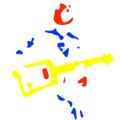Learning to use the relative names for the notes changes the way that you think about them.
Before you start
Here we start on the more traditional music theory. Before you start though make sure that you understand:
- The major scale is a sequence of notes with a particular step sequence.
- The position of each note in the sequence determines that note's function.
- The first, third and fifth notes in the major scale make up the major chord.
That's it.
The Lesson
Harmonic theory is all about understanding how each of our 12 notes behaves, or functions, in the context of a tonal centre. Before we delve deeper into these functions it will be helpful to spend just a little time learning how to name them in a better way perhaps than you're used to.
What if rather than calling them C D E etc, a name that is specific to the actual pitch of the note, you call them by their position in the major scale? Remember that it's their distance from the tonic, their position in the scale, that defines their function so if you call the fifth note in the scale the 5, then it's always the 5, regardless of the key you're playing in. Likewise the 3 is always the 3 the b3 is always the b3 and the added advantage is that we are reinforcing the functions of these notes, their sound relative to their key, every time we use the name.
The following table shows the relative names of notes in some common keys.
| Relative name | in C | in G | in E | in A | in D | in F | in Bb |
| 1 | C | G | E | A | D | F | Bb |
| 2 | D | A | F# | B | E | G | C |
| 3 | E | B | G# | C# | F# | A | D |
| 4 | F | C | A | D# | G | Bb | Eb |
| 5 | G | D | B | E | A | C | F |
| 6 | A | E | C# | F# | B | D | G |
| 7 | B | F# | D# | G# | C# | E | A |
Take Home
The first note in a scale is variously called the tonic, the one, the tonal centre, the key. The other notes all function according to their distance from that first note and we know that distance by their names.
The lesson video
Using the correct names for notes is a particular bug bear of mine, I still get complaints about it on my YouTube channel. Not here though, I think it's because my subscribers have made a real commitment to learn so are willing to make the effort to get it right, anyway.......
As I say in the video if there is one thing that gives you the most benefit for the least effort, it's learning to use the correct names for the notes. From here we can start to understand the function of the notes, how they sound, how they make us feel, and name them accordingly. Eventually when you say 'flat 3' you'll actually hear it, you'll feel the same feeling you get when you play it. It's that important!
Again, you can download the video here.
Learning the fretboard
Play the major scales you learned in the last lesson but this time name each note as you go.
